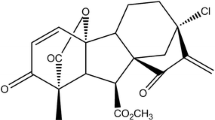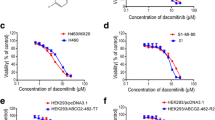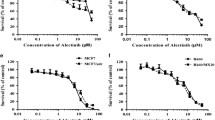Abstract
Purpose
The present study aimed to evaluate the MDR reversal activity of bromotetrandrine (BrTet), a bromized derivative of tetrandrine (Tet), in vitro and in vivo.
Methods
Drug sensitivity was determined using the MTT assay. The in vivo effect of Tet was investigated using nude mice grafted with sensitive and resistant KB human epidermoid cancer cells. Doxorubicin (Dox) accumulation was analyzed by fluorospectrophotometry and the protein and mRNA levels of P-glycoprotein (P-gp) were determined by immunocytochemistry and RT-PCR, respectively.
Results
BrTet at 0.25, 0.5 and 1 μM reversed Dox resistance in MDR human breast cancer MCF-7/Dox cells dose-dependently and its potency was greater than that of Tet at the same concentrations. BrTet reversed vincristine (VCR), Dox and paclitaxel resistance in MDR human oral epidermoid carcinoma KBv200 cells as well as innate VCR and Dox resistance in human hepatocellular carcinoma Bel7402 cells. However, BrTet showed no effect on the IC50 values of the above-mentioned anticancer drugs in sensitive MCF-7 and KB cells. No reversal effect of BrTet on the cytotoxicity of 5-fluorouracil and cisplatin, non-P-gp substrates, was observed. In nude mice bearing KBv200 xenografts on the left flank and KB xenografts on the right flank, i.p. injection of 5 mg/kg and 10 mg/kg BrTet significantly enhanced the antitumor activity of Dox against KBv200 xenografts with inhibitory rates of 33.0% and 39.2%, while Dox alone inhibited the growth of KBv200 xenografts by only 11.6%. No enhancement by BrTet was seen in KB xenografts. Moreover, BrTet at 5 mg/kg reversed paclitaxel resistance in KBv200 xenografts. Fluorospectrophotometric assay showed that BrTet significantly increased the intracellular accumulation of Dox in MCF-7/Dox cells in a dose-dependent manner. BrTet also inhibited the overexpression of P-gp in MCF-7/Dox cells, but had no effect on mdr1 expression.
Conclusions
BrTet showed significant MDR reversal activity in vitro and in vivo. Its activity may be related to the inhibition of P-gp overexpression and the increase in intracellular accumulation of anticancer drugs. BrTet may be a promising MDR modulator for eventual assessment in the clinic.






Similar content being viewed by others
Abbreviations
- BrTet :
-
Bromotetrandrine
- Dox :
-
Doxorubicin
- EDTA :
-
Ethylenediamine tetraacetic acid
- 5-FU :
-
5-Fluorouracil
- GADPH :
-
Glyceraldehyde-3-phosphate dehydrogenase
- MDR :
-
Multidrug resistance
- MTT :
-
Dimethyl thiazolyl-2,5-diphenyltetrazolium bromide
- PBS :
-
Phosphate-buffered saline
- P-gp :
-
P-glycoprotein
- Tet :
-
Tetrandrine
- VCR :
-
Vincristine
- VPM :
-
Verapamil
References
Gottesman MM, Pastan I (1993) Biochemistry of multidrug resistance mediated by the multidrug transporter. Annu Rev Biochem 62:385–427
Thiebaut F, Tsururo R, Hamada H, Gottesmann MM, Pastan I, Willingham MC (1987) Cellular localization of the multidrug resistance gene product in normal human tissues. Proc Natl Acad Sci U S A 84:7735–7738
Cordon-Cardo C, O’Brien JP, Boccia J, Casals D, Bertino JR, Melamed MR (1990) Expression of the multidrug resistance gene product (P-glycoprotein) in human normal and tumor tissues. J Histochem Cytochem 38:1277–1287
List AA (1993) Multidrug resistance: clinical relevance in acute leukemia. Oncology 7:23–32
Yuen AR, Sikic BI (1994) Multidrug resistance in lymphomas. J Clin Oncol 12:2453–2459
Arao S, Suwa H, Mandai M, Tashiro H, Miyazaki K, Okamura H, Nomura H, Hiai H, Fukumoto H (1994) Expression of multidrug resistance gene and localization of P-glycoprotein in human primary ovarian cancer. Cancer Res 54:1355–1359
Hokmayer TA, Hisenbek S, Von Hoff DD, Roninson IB (1992) Clinical correlates of MDR1 (P-glycoprotein) gene expression in ovarian and small-cell lung carcinomas. J Natl Cancer Inst 84:1486–1491
Chan HSL, Haddad G, Thorner PS, DeBoer G, Lin YP, Ondrusek N, Yeger H, Ling Y (1991) P-glycoprotein expression as a predictor of the outcome of therapy for neuroblastoma. N Engl J Med 325:1608–1614
Sanfilippo O, Ronchi E, De Marco E, Di Fronzo G, Silvestrini R (1991) Expression of P-glycoprotein in breast cancer tissue and in vitro resistance to doxorubicin and vincristine. Br J Cancer 27:155–158
Baldini N, Scotlandi K. Barbanti-Brodano G (1995) Expression of P-glycoprotein in high-grade osteosarcomas in relation to clinical outcome. N Engl J Med 333:1380–1385
Tsuruo T, Ikda H, Tsukayoshi S, Sajurai Y (1981) Overcoming of vincristine-resistant in P388 leukaemia in vivo and in vitro through enhanced cytotoxicity of vincristine and vinblastine by verapamil. Cancer Res 41:1967–1972
Georges E, Sharom FJ, Ling V (1990) Multidrug resistance and chemosensitization: therapeutic implications for cancer chemotherapy. Adv Pharmacol 21:185–220
Pennock CD, Dalton WA, Roeske WR. Appleton CP, Mosley K, Plezia P, Miller TP, Salmon SE (1991) Systemic toxic effects associated with high-dose verapamil infusion and chemotherapy administration. J Natl Cancer Inst 83:105–110
Pirker R, FitzGerald DJ, Raschack M, Frank Z, Willingham MC, Pastan L (1989) Enhancement of the activity of immunotoxins by analogues of verapamil. Cancer Res 49:4791–4795
Sikic BI (1999) Modulation of multidrug resistance: a paradigm for translational clinical research in oncology and hematology. Oncology (Basel) 5:183–187
Fracasso PM, Brady MF, Moore DH, Walker JL, Rose PG, Letvak L, Grogan TM, McGuire WP (2001) Phase II study of paclitaxel and valspodar (PSC 833) in refractory ovarian carcinoma: a gynecologic oncology group study. J Clin Oncol 19:2975–2982
Fisher GA, Lum BL, Hausdorff J, Sikic BI (1996) Pharmacological considerations in the modulation of multidrug resistance. Eur J Cancer 32A:1082–1088
Wang G, Lemos JR (1995) Tetrandrine: a new ligand to block voltage-dependent Ca2+ and Ca(+)-activated K+ channels. Life Sci 56:295–306
He QY, Meng FH, Zhang HQ (1996) Reduction of doxorubicin resistance by tetrandrine and dauricine in harringtonine-resistant human leukemia (HL60) cells. Zhongguo Yao Li Xue Bao 17:179–181
Tian H, Pan QC (1997) A comparative study on effect of two bisbenzylisoquinolines, tetrandrine and berbamine, on reversal of multidrug resistance. Yao Xue Xue Bao 32:245–250
Mosmann T (1983) Rapid colorimetric assay for cellular growth and survival: application to proliferation and cytotoxicity assays. J Immunol Methods 65:55–63
Huang M, Liu G (1999) The study of innate drug resistance of human hepatocellular carcinoma Bel7402 cell line. Cancer Lett 135:97–105
Geran RI, Greenberg NH, MacDonald MM, Schumacher AM, Abbott BJ (1972) Protocols for screening chemical agents and natural products against animal tumors and other biological systems. Cancer Chemother Rep 3:1–12
Tsuruo T, Iida H, Kitatani Y, Yokota K, Tsukagoshi S, Sakurai Y (1984) Effect of quinidine and related compounds on cytotoxicity and cellular accumulation of vincristine and Adriamycin in drug-resistant tumor cells. Cancer Res 44:4303–4307
Shinoda H, Inaba M, Tsuruo T (1989) In vivo circumvention of vincristine resistance in P388 leukemia with a novel compound, AHC-52. Cancer Res 49:1722–1726
Choi SU, Park SH, Kim KH, Choi EJ, Kim S, Park WK, Zhang YH, Kim HS, Jung NP, Lee CO (1998) The bisbenzylisoquinoline alkaloids, tetrandine and fangchinoline, enhance the cytotoxicity of multidrug resistance-related drugs via modulation of P-glycoprotein. Anticancer Drugs 9:255–256
Xu JY, Zhou Q, Shen P, Tang W (1999) Reversal effect of TTD on human multidrug resistant KBV200 cell line. J Exp Clin Cancer Res 18:549–552
Fu LW, Zhang YM, Liang YJ, Yang XP, Pan QC (2002) The multidrug resistance of tumour cells was reversed by tetrandrine in vitro and in xenografts derived from human breast adenocarcinoma MCF-7/adr cells. Eur J Cancer 38:418–426
Tunggal JK, Ballinger JR, Tannock IF (1999) Influence of cell concentration in limiting the therapeutic benefit of P-glycoprotein reversal agents. Int J Cancer 81:741–747
30. Xiao SH, Wei GL, Lu R, Liu CX, Wang FP (2004) Studies on pharmacokinetics of bromotetrandrine in animals (II). Effect on interaction of bromoisotetrandrine and adriamycin on pharmacokinetics. Asian J Drug Metabol Pharmacol 4:61–64
Luker GD, Nilsson KR, Covey DF, Piwnica-Worms D (1999) Multidrug resistance (MDR1) P-glycoprotein enhances esterification of plasma membrane cholesterol. J Biol Chem 274:6979–6991
Rowinsky EK, Smith L, Wang YM, Chaturvedi P, Villalona M, Campbell E, Aylesworth C, Eckhardt SG, Hammond L, Kraynak M, Drengler R, Stephenson J Jr, Harding MW, Von Hoff DD (1998) Phase I and pharmacokinetic study of taxol in combination with biricodar, a novel agent that reverses multidrug resistance conferred by overexpression of both MDR1 and MRP. J Clin Oncol 16:2964–2976
Acknowledgement
Partial financial support for this research was provided from the National Natural Science Foundation of China (no. 37171101).
Author information
Authors and Affiliations
Corresponding author
Rights and permissions
About this article
Cite this article
Jin, J., Wang, FP., Wei, H. et al. Reversal of multidrug resistance of cancer through inhibition of P-glycoprotein by 5-bromotetrandrine. Cancer Chemother Pharmacol 55, 179–188 (2005). https://doi.org/10.1007/s00280-004-0868-0
Received:
Accepted:
Published:
Issue Date:
DOI: https://doi.org/10.1007/s00280-004-0868-0




